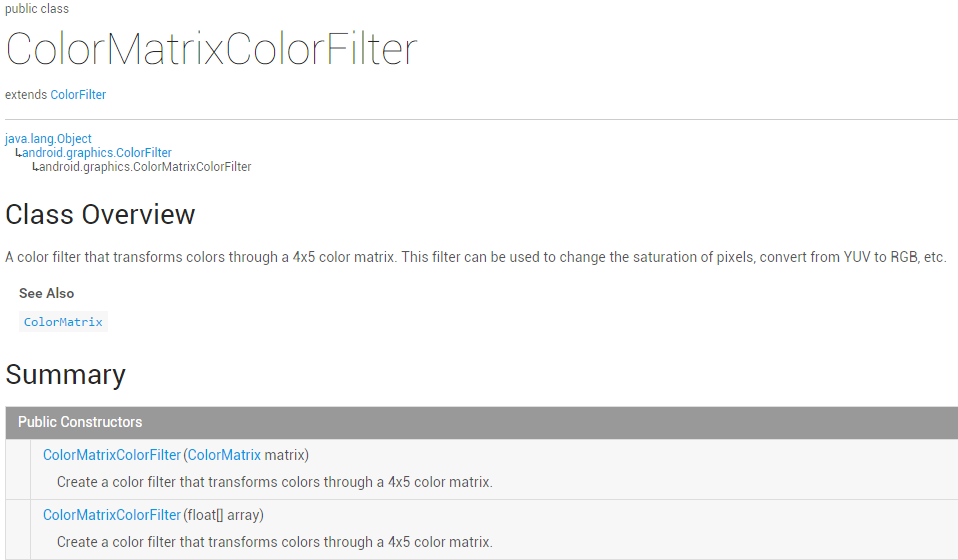本节引言:
上节我们学习了MaskFilter(面具),用它的两个子类BlurMaskFilter弄了下模糊效果,EmbossMaskFilter弄了下浮雕效果,而本节我们来学习的是另一个API——ColorFilter(颜色过滤器),和MaskFilter一样,我们并不直接使用该类,而是使用该类的三个子类:
颜色矩阵颜色过滤器:ColorMatrixColorFilter
光照色彩过滤器:LightingColorFilter
混排颜色过滤器滤器PorterDuffColorFilter
本节我们就来学习下第一个ColorMatrixColorFilter的使用吧,打开ColorMatrixColorFilter的文档,
大概说的是:通过一个4 x 5的颜色矩阵来变换颜色,可以修改像素的饱和度,将YUV转换成RGB等!而构造方法中的ColorMatrix就是颜色矩阵,也是我们学习的核心,下面听我一一道来!
1.相关常识的普及:
RGBA模型:
RGBA不知道你听过没,黄绿蓝知道了吧,光的三基色,而RAGB则是在此的基础上多了一个透明度!R(Red红色),G(Green绿色),B(Blue蓝色),A(Alpha透明度);另外要和颜料的三原色区分开来哦,最明显的区别就是颜料的三原色中用黄色替换了光三基色中的绿色!知道下就好,有兴趣的可自行百度~
一些名词:
- 色调/色相——物体传递的颜色

- 饱和度——颜色的纯度,从0(灰)到100%(饱和)来进行描述

- 亮度/明度——颜色的相对明暗程度

2.ColorMatrix的解读
如题,颜色矩阵(4 * 5),我们可以修改矩阵中的值,来实现黑白照,泛黄老照片,高对比度等效果!手撕颜色矩阵解释图如下:
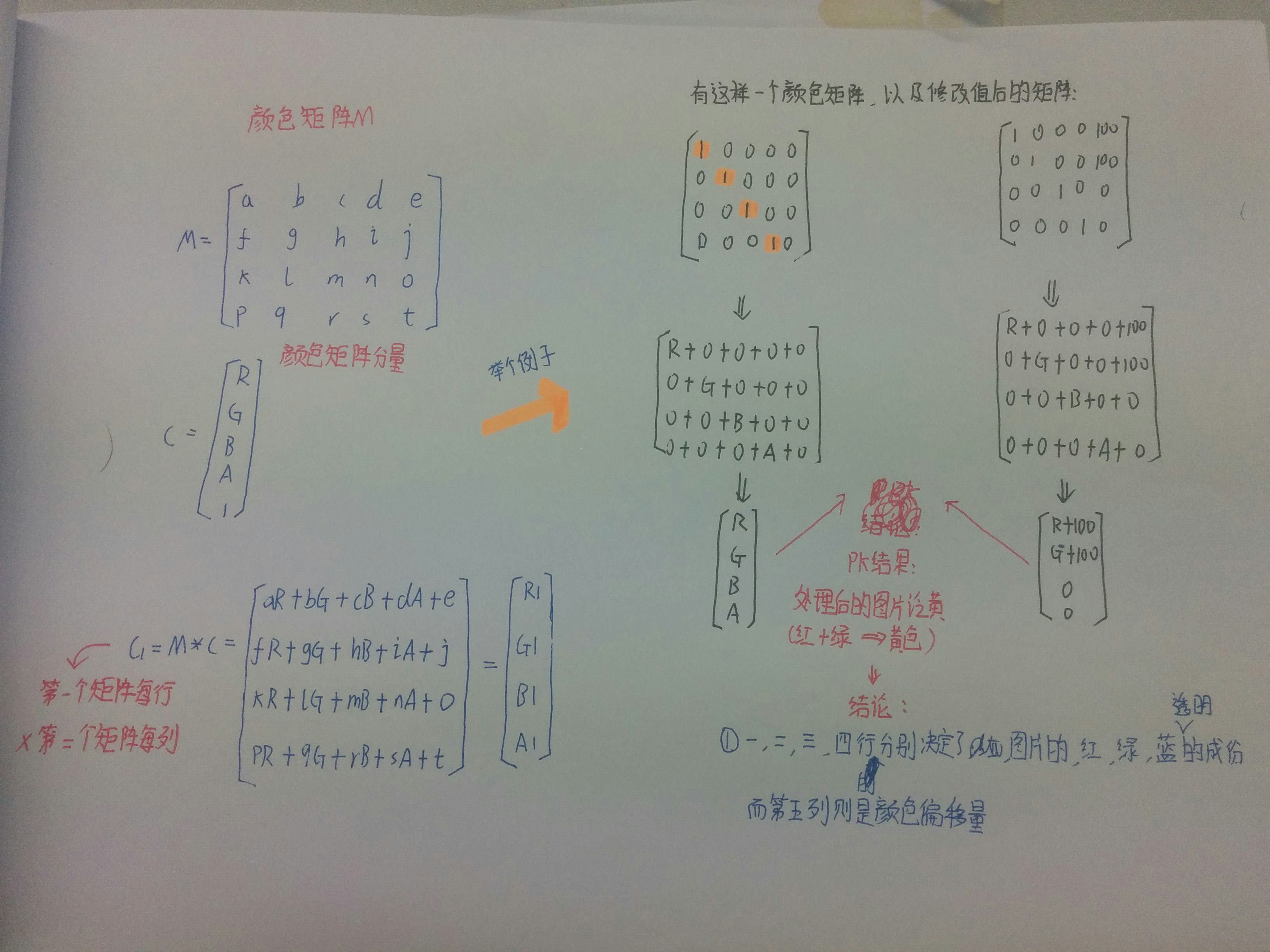
不知道你看懂上图没,如果你学过高数的话,肯定对此很熟悉,无非是矩阵的叉乘而已,没学过也没关系计算方法就是右下角那个,拿颜色矩阵的每一行来 * 颜色矩阵分量的每一列!
很典型的一个例子,处理前后的结果比较,我们还可以让某个颜色值 * 一个常数,比如让第三行(蓝)乘以2,效果就变成泛蓝色了,当然,我们肯定要写代码来验证验证上面的结果!
3.写代码来验证ColorMatrix所起的作用
这里来写烂大街的例子,一个ImageView,4 * 5个EditText,一个重置按钮和一个生成按钮,我们来看下效果图:
依次是原图,泛黄,泛绿,泛红,高对比度,色相变换,以及黄色复古

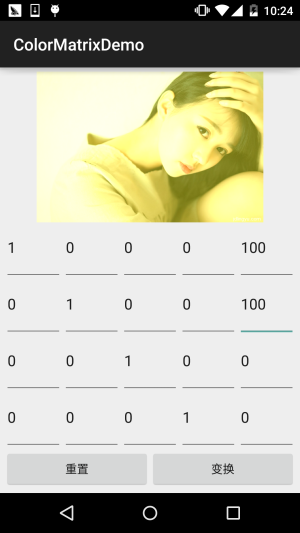
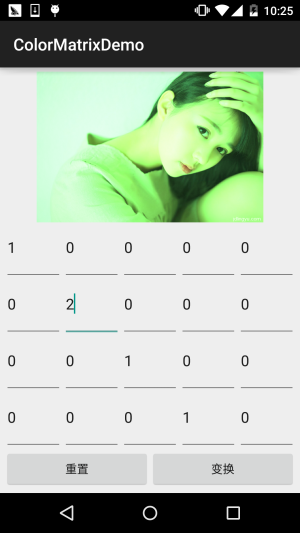



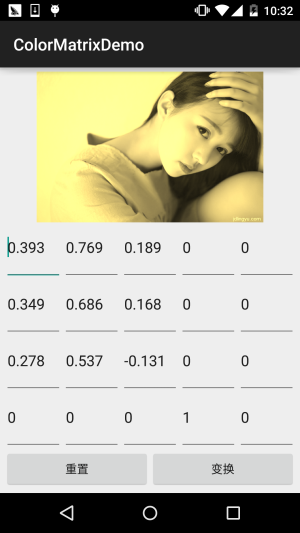
接下来我们来写代码,完成上述的效果:代码实现:
首先是布局文件activity_main.xml:
<?xml version="1.0" encoding="utf-8"?><LinearLayout xmlns:android="https://schemas.android.com/apk/res/android" android:layout_width="match_parent" android:layout_height="match_parent" android:orientation="vertical" android:padding="5dp"> <ImageView android:id="@+id/img_show" android:layout_width="match_parent" android:layout_height="0dp" android:layout_weight="2" /> <GridLayout android:id="@+id/gp_matrix" android:layout_width="match_parent" android:layout_height="0dp" android:layout_weight="3" android:columnCount="5" android:rowCount="4"></GridLayout> <LinearLayout android:layout_width="match_parent" android:layout_height="wrap_content" android:orientation="horizontal"> <Button android:id="@+id/btn_reset" android:layout_width="0dp" android:layout_height="wrap_content" android:layout_weight="1" android:text="重置" /> <Button android:id="@+id/btn_Change" android:layout_width="0dp" android:layout_height="wrap_content" android:layout_weight="1" android:text="变换" /> </LinearLayout></LinearLayout>
接着是MainActivity.java:
public class MainActivity extends AppCompatActivity implements View.OnClickListener { private ImageView img_show; private GridLayout gp_matrix; private Button btn_reset; private Button btn_Change; private Bitmap mBitmap; private int mEtWidth, mEtHeight; private EditText[] mEts = new EditText[20]; private float[] mColorMatrix = new float[20]; private Context mContext; @Override protected void onCreate(Bundle savedInstanceState) { super.onCreate(savedInstanceState); setContentView(R.layout.activity_main); mContext = MainActivity.this; bindViews(); gp_matrix.post(new Runnable() { @Override public void run() { mEtWidth = gp_matrix.getWidth() / 5; mEtHeight = gp_matrix.getHeight() / 4; //添加5 * 4个EditText for (int i = 0; i < 20; i++) { EditText editText = new EditText(mContext); mEts[i] = editText; gp_matrix.addView(editText, mEtWidth, mEtHeight); } initMatrix(); } }); } private void bindViews() { img_show = (ImageView) findViewById(R.id.img_show); gp_matrix = (GridLayout) findViewById(R.id.gp_matrix); btn_reset = (Button) findViewById(R.id.btn_reset); btn_Change = (Button) findViewById(R.id.btn_Change); mBitmap = BitmapFactory.decodeResource(getResources(), R.mipmap.img_meizi); img_show.setImageBitmap(mBitmap); btn_reset.setOnClickListener(this); btn_Change.setOnClickListener(this); } //定义一个初始化颜色矩阵的方法 private void initMatrix() { for (int i = 0; i < 20; i++) { if (i % 6 == 0) { mEts[i].setText(String.valueOf(1)); } else { mEts[i].setText(String.valueOf(0)); } } } //定义一个获取矩阵值得方法 private void getMatrix() { for (int i = 0; i < 20; i++) { mColorMatrix[i] = Float.valueOf(mEts[i].getText().toString()); } } //根据颜色矩阵的值来处理图片 private void setImageMatrix() { Bitmap bmp = Bitmap.createBitmap(mBitmap.getWidth(), mBitmap.getHeight(), Bitmap.Config.ARGB_8888); android.graphics.ColorMatrix colorMatrix = new android.graphics.ColorMatrix(); colorMatrix.set(mColorMatrix); Canvas canvas = new Canvas(bmp); Paint paint = new Paint(Paint.ANTI_ALIAS_FLAG); paint.setColorFilter(new ColorMatrixColorFilter(colorMatrix)); canvas.drawBitmap(mBitmap, 0, 0, paint); img_show.setImageBitmap(bmp); } @Override public void onClick(View v) { switch (v.getId()) { case R.id.btn_Change: getMatrix(); setImageMatrix(); break; case R.id.btn_reset: initMatrix(); getMatrix(); setImageMatrix(); break; } }}代码非常的简单,就加载布局,然后往GridLayout里面塞 5 * 4 个EditText,这里用post()方法是为了保证GridLayout加载完毕后才去获取长宽,不然在获取GridLayout长宽的时候可是获取不到值的!接着定义了三个方法,初始矩阵,获取矩阵值,以及根据矩阵值来处理图片~是不是很简单咧~
不过到这里你可能有一点疑问:
" 难道处理图像我们只能这样修改颜色矩阵么?次次都这样肯定很麻烦,谁会去记矩阵里的应该填的值?有没有简单一点处理图片的方法? "
答:肯定是有的,我们可以看回文档,我们可以发现几个很常用的方法:setRotate(int axis, float degrees):设置色调
setSaturation(float sat):设置饱和度
setScale(float rScale, float gScale, float bScale, float aScale):设置亮度
下面我们写个例子来试下这个三个方法!
4.使用ColorMatrix的三个方法处理图像
运行效果图:

代码实现:
首先我们来编写一个图片处理的工具类,我们传入Bitmap,色相,饱和度以及亮度,处理后,返回处理后的图片:ImageHelper.java:
/** * Created by Jay on 2015/10/28 0028. */public class ImageHelper { /** * 该方法用来处理图像,根据色调,饱和度,亮度来调节 * * @param bm:要处理的图像 * @param hue:色调 * @param saturation:饱和度 * @param lum:亮度 * */ public static Bitmap handleImageEffect(Bitmap bm, float hue, float saturation, float lum) { Bitmap bmp = Bitmap.createBitmap(bm.getWidth(), bm.getHeight(), Bitmap.Config.ARGB_8888); Canvas canvas = new Canvas(bmp); Paint paint = new Paint(Paint.ANTI_ALIAS_FLAG); ColorMatrix hueMatrix = new ColorMatrix(); hueMatrix.setRotate(0, hue); //0代表R,红色 hueMatrix.setRotate(1, hue); //1代表G,绿色 hueMatrix.setRotate(2, hue); //2代表B,蓝色 ColorMatrix saturationMatrix = new ColorMatrix(); saturationMatrix.setSaturation(saturation); ColorMatrix lumMatrix = new ColorMatrix(); lumMatrix.setScale(lum, lum, lum, 1); ColorMatrix imageMatrix = new ColorMatrix(); imageMatrix.postConcat(hueMatrix); imageMatrix.postConcat(saturationMatrix); imageMatrix.postConcat(lumMatrix); paint.setColorFilter(new ColorMatrixColorFilter(imageMatrix)); canvas.drawBitmap(bm, 0, 0, paint); return bmp; }}接下来我们把布局也撸出来,activity_main.xml:
<?xml version="1.0" encoding="utf-8"?><RelativeLayout xmlns:android="https://schemas.android.com/apk/res/android" android:layout_width="match_parent" android:layout_height="match_parent" android:orientation="vertical" android:padding="5dp"> <ImageView android:id="@+id/img_meizi" android:layout_width="300dp" android:layout_height="300dp" android:layout_centerHorizontal="true" android:layout_marginBottom="24dp" android:layout_marginTop="24dp" /> <TextView android:id="@+id/txt_hue" android:layout_width="wrap_content" android:layout_height="32dp" android:layout_below="@id/img_meizi" android:gravity="center" android:text="色调 :" android:textSize="18sp" /> <SeekBar android:id="@+id/sb_hue" android:layout_width="match_parent" android:layout_height="32dp" android:layout_below="@id/img_meizi" android:layout_toRightOf="@id/txt_hue" /> <TextView android:id="@+id/txt_saturation" android:layout_width="wrap_content" android:layout_height="32dp" android:layout_below="@id/txt_hue" android:gravity="center" android:text="饱和度:" android:textSize="18sp" /> <SeekBar android:id="@+id/sb_saturation" android:layout_width="match_parent" android:layout_height="32dp" android:layout_below="@id/sb_hue" android:layout_toRightOf="@id/txt_saturation" /> <TextView android:id="@+id/txt_lun" android:layout_width="wrap_content" android:layout_height="32dp" android:layout_below="@id/txt_saturation" android:gravity="center" android:text="亮度 :" android:textSize="18sp" /> <SeekBar android:id="@+id/sb_lum" android:layout_width="match_parent" android:layout_height="32dp" android:layout_below="@id/sb_saturation" android:layout_toRightOf="@id/txt_lun" /></RelativeLayout>
最后是我们的MainActivity.java:
public class MainActivity extends AppCompatActivity implements SeekBar.OnSeekBarChangeListener{ private ImageView img_meizi; private SeekBar sb_hue; private SeekBar sb_saturation; private SeekBar sb_lum; private final static int MAX_VALUE = 255; private final static int MID_VALUE = 127; private float mHue = 0.0f; private float mStauration = 1.0f; private float mLum = 1.0f; private Bitmap mBitmap; @Override protected void onCreate(Bundle savedInstanceState) { super.onCreate(savedInstanceState); setContentView(R.layout.activity_main); mBitmap = BitmapFactory.decodeResource(getResources(), R.mipmap.img_meizi); bindViews(); } private void bindViews() { img_meizi = (ImageView) findViewById(R.id.img_meizi); sb_hue = (SeekBar) findViewById(R.id.sb_hue); sb_saturation = (SeekBar) findViewById(R.id.sb_saturation); sb_lum = (SeekBar) findViewById(R.id.sb_lum); img_meizi.setImageBitmap(mBitmap); sb_hue.setMax(MAX_VALUE); sb_hue.setProgress(MID_VALUE); sb_saturation.setMax(MAX_VALUE); sb_saturation.setProgress(MID_VALUE); sb_lum.setMax(MAX_VALUE); sb_lum.setProgress(MID_VALUE); sb_hue.setOnSeekBarChangeListener(this); sb_saturation.setOnSeekBarChangeListener(this); sb_lum.setOnSeekBarChangeListener(this); } @Override public void onProgressChanged(SeekBar seekBar, int progress, boolean fromUser) { switch (seekBar.getId()) { case R.id.sb_hue: mHue = (progress - MID_VALUE) * 1.0F / MID_VALUE * 180; break; case R.id.sb_saturation: mStauration = progress * 1.0F / MID_VALUE; break; case R.id.sb_lum: mLum = progress * 1.0F / MID_VALUE; break; } img_meizi.setImageBitmap(ImageHelper.handleImageEffect(mBitmap, mHue, mStauration, mLum)); } @Override public void onStartTrackingTouch(SeekBar seekBar) {} @Override public void onStopTrackingTouch(SeekBar seekBar) {}}代码同样很简单,这里就不讲解了~
5.本节代码示例下载:
本节小结:
好的,本节跟大家介绍了ColorFilter中的第一个ColorMatrixColorFilter,颜色矩阵过滤器其实核心还是ColorMatrix,我们通过该类处理图片可以自己设置4*5矩阵的值,又或者直接调用ColorMatrix给我们提供的设置色调,饱和度,亮度的方法!图像处理无非就这样,还有一种是修改像素点形式的,后面也会讲,本节内容参考自——医生(徐宜生)的慕客网视频:Android图像处理-打造美图秀秀从它开始,不想看文字的可以看视频,讲得还是蛮赞的~






